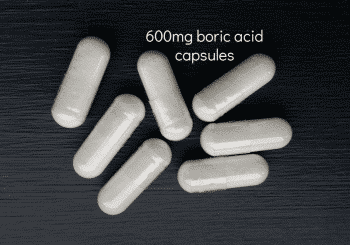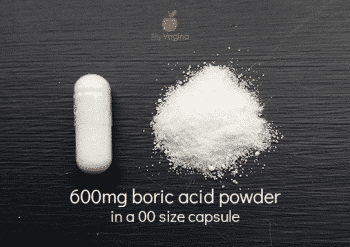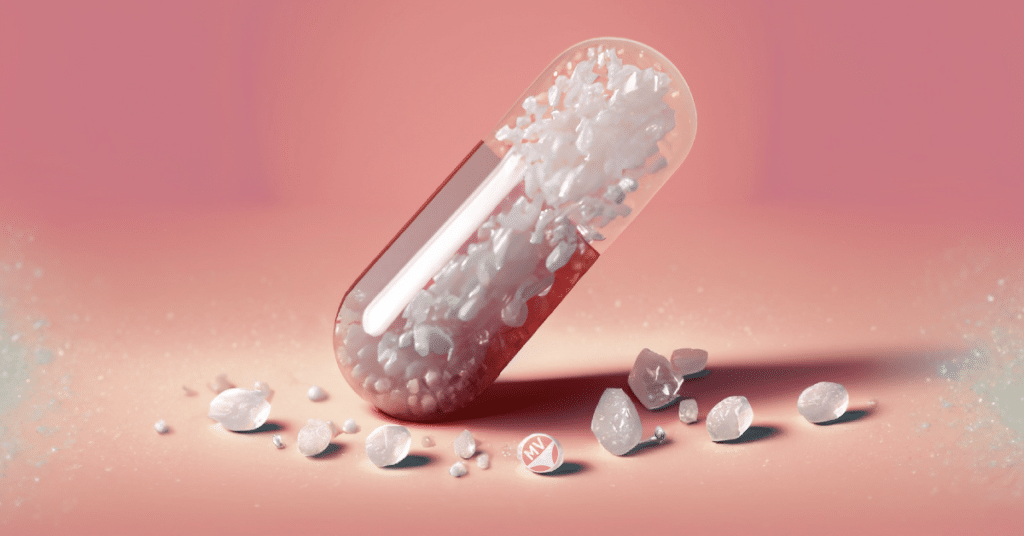There is a lot of information about boric acid online for use as both a pesticide and a vaginal application. This can make it seem scary to use in your vagina.
Before you use boric acid vaginally, it pays to understand how boric acid works on bacteria and fungi cells. Boric acid does kill some insects, but only insects that groom themselves. This is why it’s useful as a pesticide. You can think of boric acid more like salt than anything else – it looks like salt and is considered as non-toxic as salt.
How boric acid works to kill bacteria, fungi, and some insects
Insects that groom ingest the boric acid on their body, and it overwhelms their system and they die. If an insect doesn’t groom, boric acid does not affect them. In some bacteria and fungi cells, boric acid affects the cell wall in a negative way, causing either the microbe to die or to disable its reproductive abilities.1
If a microbe can’t reproduce itself, then once it dies, that’s it. Game over. This means your vaginal symptoms will last as long as it takes for that microbe to die. Most microbes don’t have a very long lifespan, so often boric acid tends to work quite quickly.
Is boric acid poisonous?
Boric acid is not poisonous in the usual sense, just like salt isn’t poisonous in the usual sense, but it can be toxic if used incorrectly and in high doses for a long period of time.
There is a great deal of research into boric acid vaginally, and gynaecologists may prescribe it if other yeast infection treatments don’t work. Boric acid is a useful tool to have in your arsenal against vaginal infections of any kind.
How does boric acid work?
Boric acid promotes an acidic environment (which our good bugs like) while also having a bacteriostatic action against pathogens. Bacteriostatic means that it stops the microbe from reproducing, but may not kill them outright.
Don’t overuse boric acid – stop vaginal treatments when your symptoms go away, unless otherwise told by a healthcare professional as part of a greater plan. It can pay to do an extra day or two to make sure whatever was in there is gone, but play it by ear and see how you go.
It’s pretty hard to do boric acid wrong, so long as you only do one treatment per day, and don’t do it for months at a time. Do not eat boric acid.
You can buy boric acid cheaply – don’t pay a lot for boric acid, as it is an inexpensive product.


Medical scientists have studied the use of boric acid in the vagina and have recommended its use in a limited capacity.
Boric acid is not an alternative medicine practice, per se. You are just as likely to be recommended boric acid vaginally by your gynaecologist as your naturopath.
Understanding boric acid, boron and borax
To understand boric acid, we first need to establish the difference between boric acid, boron, and borax.
Borax
Naturally-occurring mineral mined from dry salt lakes. Mined just like regular salt. Comes in four forms, four boron atoms, plus two sodium atoms, and varying amounts (including zero) of crystallisation water (oxygen and water).2
Usually sold pure or almost pure. In the stomach, borax reacts with hydrochloric acid and forms boric acid and sodium chloride. The boron content of borax is about 11.3 per cent. All borax is the same, like salt is – it is mined and then sold.
There is no pharmaceutical grade or agricultural grade or food grade. Some people use diluted borax for its boron content as a food supplement in small doses.
Boron
Boron is a chemical element, and a part of borax and boric acid. Boron is present in fruit and vegetables, and is a part of healthy soil. You can be deficient in boron.
Each day, people who eat a lot of fruit and vegetables would ingest between two and five milligrams of boron per day, but most of us would be sitting at about one or two milligrams per day. Poor soil and overcooking means less boron.
Boric Acid
Boric acid contains 17.5 per cent boron. Boric acid is non-toxic to wildlife, especially birds and frogs, but mildly toxic to fish, and non-toxic in normal doses for humans.
All borax, boric acid and boron are considered low-toxicity salts. Table salt is a comparable salt. The reason there is so much legislation involving borax and boric acid is that it used to be a food preservative (so we were ingesting it).
Eating it was amongst many other ways that people were getting sick from it, like putting it repeatedly into cuts to act as an antiseptic, where it leached continuously into the blood. This was put to an end in many countries since it presented a public health issue – people were taking high doses for long periods of time.
Borax, boric acid and boron are useful or even essential in our environment and food supply. Boric acid can be used safely – there is a lot of evidence that boron is a very important and useful chemical element that has a bit of a complicated reputation.
Don’t let the word ‘acid’ scare you off either. It’s a chemical name, similar to ascorbic acid (vitamin C) and acetic acid (vinegar).
Quick warnings on boric acid
- Do not use boric acid if you are pregnant or lactating – no safety data exists (you could swap it out for vitamin C after a chat with your doctor)3
- Do not eat boric acid – toxicity is far greater than vaginally
- Use caution when using boric acid for more than two weeks consecutively (because we don’t know what the impact is, because it hasn’t been studied)
What is boric acid?
Boric acid (also boracic acid, orthoboric acid) is a white, odourless powder that comes in crystals or granules. Vaginal suppositories of boric acid are not commercially available, and so you have to make them up yourself. It is not considered a human or animal carcinogen.
What is the studied vaginal dose?
The dose most studied is 600mg of boric acid powder in a gelatine (veggie) capsule vaginally. Just because it hasn’t been studied, however, doesn’t mean you can’t experiment, but read the research and see what you consider the parameters to be.
How does boric acid work to solve vaginal infections?
Boric acid is a weak topical bacteriostatic and fungistatic, meaning it stops microbes from reproducing, but does not kill them. We’re not sure why exactly this is.
Boric acid is weaker on the pH scale than vitamin C, so the acidity is not the primary mode of action, though it helps. The fungistatic action may be related to acidity, however, since the acidity can penetrate the cell wall of some fungi and disrupt the membrane.
But, studies looking at what the lowest concentration of boric acid is that inhibits microbes show that boric acid works at a pH similar to the untreated vaginal tract, so the acidity theory isn’t particularly strong.
Ingestion and absorption of boric acid
Boric acid, when eaten, is quickly and completely absorbed, and is well-absorbed through unprotected or open skin in both liquid and powder form. Absorption through intact skin is thought to be negligible. Once boric acid is absorbed, it is sent throughout the entire body. When used vaginally, it is absorbed, but not as much as when eaten nor as little when in contact with intact skin.
How boric acid is metabolised and excreted
Boric acid is not really metabolised, and is excreted in its whole form (more or less) by the kidneys. About half is excreted within 12 hours of taking it (the half-life), and 90 per cent is excreted within 96 hours. Very little is excreted in faeces, sweat and saliva.
In the vagina, absorption of boric acid after insertion of one to two 600mg boric acid capsules for one to two weeks in eight healthy volunteers resulted in no volunteer having detectable boric acid levels 48 hours after the end of treatment.
Boron blood levels below 200 pg/ml are considered to be safe by many researchers, with the average blood concentration being about 46 pg/ml in the volunteers during the treatment. This means that any treatment could potentially be about three times greater than a 600mg daily dose and still be considered safe.
One volunteer had her blood boron analysis done after a single 600mg boric acid capsule, revealing about six per cent absorption from the vagina, and a half-life of 10.5 hours. A half-life of 21 hours has been reported after intravenous application in eight healthy males.
Side-effects and interactions of boric acid vaginally
Short courses of intra-vaginal boric acid are generally well tolerated. The most commonly reported side-effects are mild, and include a watery discharge, redness, burning, and a male sex partner feeling grit on his penis during vaginal sex. No drug interactions have so far been reported involving boric acid.
Long-term safety is unknown, so using boric acid for more than one to two weeks at a time has unknown impacts. There is some controversy regarding boric acid due to toxicities, with a problematic occurrence in 1888 (yes, 1888!) where intravaginal treatments caused poisoning after vaginal applications. Studies have not repeated this, so it is unknown what dose was applied.
Risks and symptoms of boric acid toxicity
Toxicity is measured by how much of the element boron a product contains. A fatal dose orally is considered to be 20 grams (0.1 – 0.5 mg/kg). Boric acid toxicity affects the digestive tract, central nervous system, skin, liver, and kidneys.4
Symptoms of boric acid toxicity are vomiting, diarrhoea, or abdominal pain, but may extend to over-excitement of the nervous system which is then followed by lethargy and fatigue, headaches, seizures, coma, and high fever. The kidneys are affected. Death can occur within 3-5 days of acute poisoning.
Systemic toxicity and side-effects from vaginal administration
Toxicity caused by vaginal application of boric acid is believed to be minimal, but symptoms might include loss of appetite, digestive problems, weakness, confusion, dermatitis, menstrual disorders, anaemia, seizures and loss of hair (alopecia).
Antimicrobial action of boric acid – how it works
Boric acid has some activity against staphylococci and streptococci, though this is theorised to be bacteriostatic (stops microbes from reproducing, but does not kill them) and slow to occur.
Yeast-killing action of boric acid
Boric acid is most commonly associated with its antifungal activity.5,6 In vitro studies using boric acid concentrations ranging from 0.4 – 5.0 per cent have been found to inhibit Candida albicans isolates. A dose of 500mg boric acid has been found to reportedly kill 50 – 90 per cent of C. albicans isolates in 48 hours.
Vaginal yeast infections were most often caused by C. albicans isolates, however this is changing, and more non-C. albicans isolates are causing yeast infections. The most common of those is C. glabrata isolates, which are resistant to fluconazole and itraconazole, the typical antifungal treatment that works against C. albicans.
Boric acid may have improved activity against these other yeasts, and has demonstrated efficacy against C. glabrata isolates.
Boric acid may also have antifungal activity against Saccharomyces cerevisiae, a microbe that can cause vaginitis.
Gynaecologists may recommend boric acid as a safe home remedy for treating vaginal yeast infections.
Borax and boric acid as an insecticide, pesticide and herbicide
Boric acid’s impact on insects varies, since only insects that groom are affected. The insect grooms, and as it does so it ingests boric acid, thus poisoning them and killing them – their little system is not set up to deal with boric acid. Plants dry out in the presence of boric acid, and thus cell death is a consequence.
Many molecules are poisonous to insects and plants, but fine for humans or animals.
Think of the way chocolate can kill a dog, or how mosquitoes hate smoke. Understanding the chemistry of a substance is key to understanding how it will behave when it comes into contact with animals, humans, insects or plants.
It’s science!
References7
- 1.Meers PD, Chow CK. Bacteriostatic and bactericidal actions of boric acid against bacteria and fungi commonly found in urine. Journal of Clinical Pathology. Published online June 1, 1990:484-487. doi:10.1136/jcp.43.6.484
- 2.Zumreoglu-Karan B, Kose DA. Boric acid: a simple molecule of physiologic, therapeutic and prebiotic significance. Pure and Applied Chemistry. Published online January 6, 2015:155-162. doi:10.1515/pac-2014-0909
- 3.Mittelstaedt R, Kretz A, Levine M, et al. Data on Safety of Intravaginal Boric Acid Use in Pregnant and Nonpregnant Women: A Narrative Review. Sexual Trans Dis. Published online September 23, 2021:e241-e247. doi:10.1097/olq.0000000000001562
- 4.Hadrup N, Frederiksen M, Sharma AK. Toxicity of boric acid, borax and other boron containing compounds: A review. Regulatory Toxicology and Pharmacology. Published online April 2021:104873. doi:10.1016/j.yrtph.2021.104873
- 5.Iavazzo C, Gkegkes ID, Zarkada IM, Falagas ME. Boric Acid for Recurrent Vulvovaginal Candidiasis: The Clinical Evidence. Journal of Women’s Health. Published online August 2011:1245-1255. doi:10.1089/jwh.2010.2708
- 6.De Seta F, Schmidt M, Vu B, Essmann M, Larsen B. Antifungal mechanisms supporting boric acid therapy of Candida vaginitis. Journal of Antimicrobial Chemotherapy. Published online November 19, 2008:325-336. doi:10.1093/jac/dkn486
- 7.Powell A, Ghanem KG, Rogers L, et al. Clinicians’ Use of Intravaginal Boric Acid Maintenance Therapy for Recurrent Vulvovaginal Candidiasis and Bacterial Vaginosis. Sexual Trans Dis. Published online October 29, 2019:810-812. doi:10.1097/olq.0000000000001063

Get a fresh perspective with a qualified, experienced vulvovaginal specialist naturopath.
This product has multiple variants. The options may be chosen on the product page
The most comprehensive vaginal microbiome test you can take at home, brought to you by world-leading vaginal microbiome scientists at Juno Bio.
Easy-to-use BV and AV treatment program.

Promote and support a protective vaginal microbiome with tailored probiotic species.







